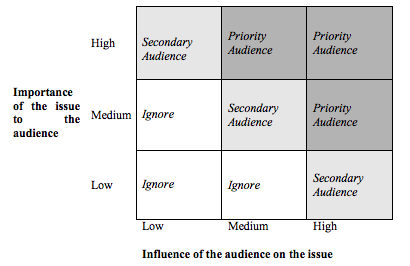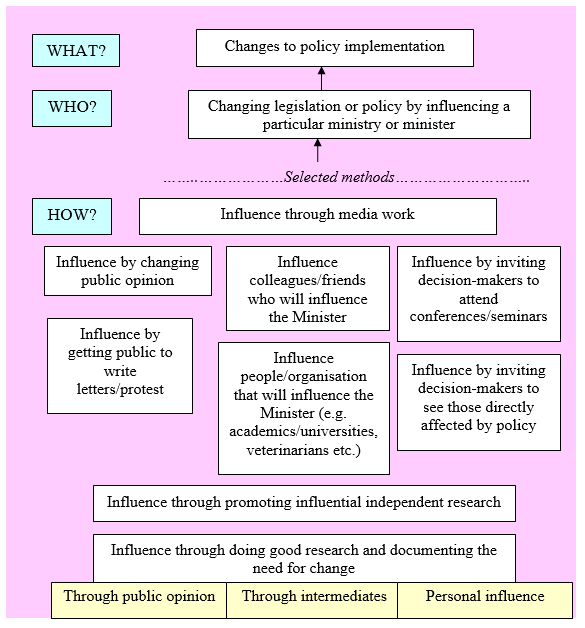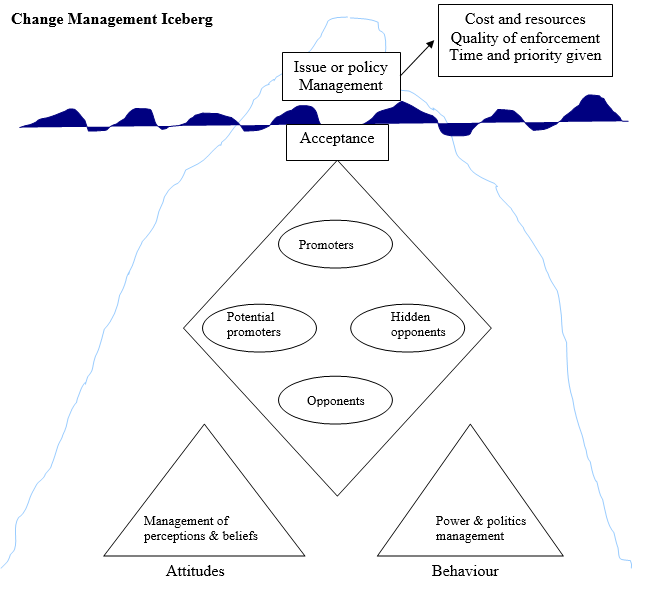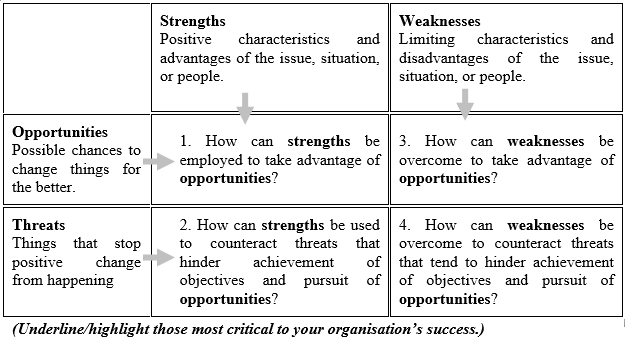
19. Audience Prioritization Matrix

Category:
Recommended
Description and Purpose:
This tool maps influence against the importance of the issue to the stakeholder. It is a useful stakeholder analysis tool.
Method
For each stakeholder identified, map in the chart below – measuring the level of importance of the issue to them on the horizontal axis and their degree of influence on the vertical.

From the Audience Prioritization matrix, you can immediately identify whether the stakeholder is an important audience that cannot be ignored – due to the combination of their influence and how much importance they give the issue.
For stakeholders with high influence, who do not consider the issue important you may consider:
- For potential allies – tactics and messages to move the issue up their priority ranking
- For opponents – treating with caution, or carefully selected diversionary tactics.
18. Johari's Window

Category:
Recommended
Description and Purpose:
This tool maps influence against the level of involvement in the advocacy issue. It is a useful stakeholder analysis tool.
Method:
For each stakeholder identified, map in the chart below – measuring the level of influence horizontally and their degree of involvement vertically.
Johari's Window Model
| Influence | High | Careful with them Consider trying to involve? |
Key |
| Low | Ignore | Increase to key? | |
| Low | High | ||
| Involvement | |||
The windows indicate the type of strategies which could be considered, depending on the exact circumstances.
17. Stakeholder Analysis

Category:
A Primary Tool
Description and Purpose:
This tool is used to establish the relative importance and influence of people, groups or institutions with an interest in the advocacy campaign. It can be used in conjunction with a Venn Diagram and other stakeholder mapping tools.
In this context, a stakeholder is somebody who is affected by the policy issue, or who could affect that decision. By doing a stakeholder analysis around an issue, we can identify allies and opponents, and channels of influence who can make the most impact on a decision.
Method:
To carry out a stakeholder analysis, go through the following process:
Firstly, brainstorm all the stakeholders for the issue. The aim here is to be creative and obtain a long list, which you should write in the following table.
Next, apply three filter questions to the list of stakeholders:
- To what extent does the stakeholder agree or disagree with your position?
- How importantly, relative to the others, does the stakeholder view the issue?
- How influential, relative to the others, is the stakeholder over the decision?
| Stakeholder | Attitude of the stakeholder to your position | Importance of the issue to the stakeholder | Influence of the stakeholder over the issue |
| AA A N P PP | L M H | L M H | |
| AA A N P PP | L M H | L M H | |
| AA A N P PP | L M H | L M H | |
| AA A N P PP | L M H | L M H | |
| AA A N P PP | L M H | L M H | |
| AA A N P PP | L M H | L M H | |
| AA A N P PP | L M H | L M H | |
| AA A N P PP | L M H | L M H | |
| AA A N P PP | L M H | L M H | |
| AA A N P PP | L M H | L M H |
AA = Very anti; A = Anti; N = Neutral; P = Pro; PP = Very pro, LMH = Low, Medium, High
Having answered the questions, transfer the information to the following stakeholder analysis tools:
6. Allies and Opponents Matrix
18. Johari's Window
19. Audience Prioritization Matrix
by writing the stakeholders’ names into the appropriate boxes.
The information is easier to interpret on the matrices than it is directly from the table. Also, include interpretive notes.
If a facilitator is used, their role is to use open questions to check the reasons and logic for the group’s decisions.
From the Audience Prioritization Matrix, you can immediately identify whether the stakeholder is an important audience that cannot be ignored – due to the combination of their influence and how much importance they give the issue.
From the Allies & Opponents Matrix, you can identify who are your most significant allies and opponents, and who the most influential neutrals are.
From Johari’s Window you can identify stakeholders with influence and the likelihood that they will be involved in the issue
However, the stakeholder groups are not fixed in their positions and you can try to influence them. From the matrices, you can identify which of the following influencing strategies would be most appropriate:
- Build alliances (with allies)
- Persuading the stakeholder that the issue is important (mainly for allies with high influence but low interest/involvement)
- Persuading the stakeholder that your position is right (mainly for influential neutrals and soft opponents)
- Helping to increase the influence of the stakeholder (mainly for allies with low influence)
- Reducing the influence of the stakeholder (mainly for opponents with high influence)
Overall, you need to identify how many stakeholder groups you can realistically target as audiences, given your level of resources.
Interpret the results and determine your influencing strategy:
- Who are the priority stakeholders?
- Who are your most important allies and opponents, neutrals?
- What options do you have for shifting the balance of power and ideas?
16. Strategies to Counter Power Blocks

Category:
Optional
Description and Purpose:
This is a diagram that provides advice on strategies that may be successful in countering power blocks.
Method
Use the following diagram as a guide when you identify power blocks when charting your advocacy strategy.
Given the complex dynamics of power, strategies that only address formal decision-making processes and rely solely on good information and reasoned arguments will almost never result in long-term favorable social change. Informal decision-makers such as chiefs and religious leaders also need attention as do strategies that address all other forms of power over
| Power that shapes and maintains unjust and inequitable norms, values and consciousness | Power that keeps our issues off political agendas | Power that excludes animal welfare voices from being heard | Power that prevents formal political decisions and implementation working to favor animal welfare |
| Consciousness-raising: Challenges ideologies and belief systems that perpetuate injustice through analysis and awareness building, work to promote sense of rights and responsibilities (citizenship), political awareness, analysis of problems, sense of collaboration, respect etc. |
Research and dissemination: Investigation, action research and sharing of information that uncovers concealed data, develops alternatives and legitimizes and values the issues and agendas. Organizing and Mobilizing: Building active critical constituencies and movements around common problems, concerns and injustices. Promoting and supporting efforts to improve animal welfare. Changing public opinion: Through radio shows, campaigns etc. |
Strengthening capacity: Strengthening organizations, skills & access to information. Nurturing organizations and leadership building: Strengthening constituency organizations, coalitions, social movements and structures. Mobilizing around shared agendas. Research & dissemination of information that legitimizes groups & strengthens their knowledge. |
Public and policy influence strategies: Lobbying, advocacy, campaigning, monitoring; negotiation, litigation; public education, media; policy research, policy alternatives; marches, demonstrations, vigils. Voting, running for office. Collaboration, modelling and promoting welfare-friendly alternatives, etc. |
| Given the complex dynamics of power, strategies that only address formal decision-making processes and rely solely on good information and reasoned arguments will almost never result in long-term favorable social change. Informal decision-makers such as chiefs and religious leaders also need attention as do strategies that address all other forms of power over. | |||
Amended from: Critical Webs of Power and Change. Action Aid International. November 2005.
15. Pathways of Influence

Category:
Recommended
Description and Purpose:
This is a diagram that examines the different pathways of influence. It can be used as a guide when determining advocacy strategies. The different methods of influence are charted as being achieved in three ways: through public opinion, intermediates, or personal contact.
Method:
Use the following model as a guide when charting your advocacy strategy.
(Adapted from: R. David, 1998, as reproduced from Chapman and Wameyo 2001)
14. Change Management Iceberg

Category:
Recommended
Description and Purpose:
The advocacy self-assessment is a tool that can be used to consider the different factors affecting your policy issue.
Method:
Use the following diagram as a guide when considering the factors – hidden and exposed – that affect the process of change.
You can use the results to decide on how to manage these throughout the change process – remembering that those ‘under the water level’ need to be managed until the change is permanent.
Opponents have a negative attitude towards change, and negative behaviour towards this particular change. They need a change of perception and beliefs, as far as possible.
Promoters have a general positive attitude towards change, and behave positively towards this change. They view it as advantageous, so will promote it.
Hidden opponents have a negative attitude towards change, but appear to support this particular change. They need a change of perception and beliefs, supported by information.
Potential promoters a general positive attitude towards change, but are not yet convinced about this particular change. Power and politics management could help to make them promoters.
Even after the change has been accepted and agreed, the forces below water level need to be managed to prevent regression.
13. Advocacy Self Assessment

Category:
Recommended
Description and Purpose:
The advocacy self-assessment is a tool that can be used to assist a SWOT analysis (see above).
Method:
Use the following chart to initiate the SWOT process, if there are no precise criteria already provided.
After identifying strengths and weaknesses, organizations and coalitions should try to determine ways to employ strengths to their advantage and modify weaknesses. Developing activities and institutional changes can benefit not only an organization but also the effectiveness of an advocacy campaign.
| Organizational Capabilities | Strengths | Weaknesses |
| Knowledge of the problem or issues |
||
| Understanding the aim | ||
| Understanding of the advocacy environment and context |
||
| Ability to develop the advocacy message |
||
| Ability to transmit the advocacy message |
||
| Promoting participation in the decision-making process |
||
| Quality of leadership | ||
| Diversity of membership/staff |
||
| External Relationships | Strengths | Weaknesses |
|
Ability to influence key |
||
| Ability to mobilize populations |
||
| Ability to caolition build | ||
| Ability to access media outlets |
||
| Resources | Strengths | Weaknesses |
| Human capacity | ||
| Material resources | ||
| Technological resources | ||
| Financial resources |
Adapted from the Manual for Facilitators of Advocacy Training Sessions, Washington Office on Latin America, 2001
12. SWOT Analysis - Strengths, Weaknesses, Opportunities, Threats

Category:
A Primary Tool
Description and Purpose:
The SWOT analysis is a commonly used matrix tool that can provide an objective and critical self-assessment as a background to strategic planning. SWOT stands for:
- Strengths
- Weaknesses
- Opportunities
- Threats
It looks at both the external and internal factors of an organization:
- Strengths and Weaknesses are internal to the organization.
- Opportunities and Threats are external to the organization.
This tool can deal with broad or narrow issues, as long as they are clear and understandable.
Method:
Draw a matrix that has nine fields (three rows and three columns). Label the fields as Strengths, Weaknesses Opportunities and Threats as shown below.
Participants begin by listing all strengths and weaknesses in the respective fields.
Strengths: Key strengths, core competencies/capabilities or (especially) unique advantages (‘Unique Selling Points’)
Weaknesses: Weaknesses in the organization – things it does less well and/or cannot cope with
Include aspects of skills and resources (see above).
This is repeated for opportunities and threats.
Opportunities: Opportunities that may arise for the organization
Threats: Potential threats to the organization and its work (From clients, from partners/competitors, from external environment)
In some circumstances, it may be more useful to substitute Constraints for Threats (making it a SWOC analysis).
Research and/or brainstorming can be used to generate the factors. If there is a facilitator, they can encourage discussion and analysis. The four empty fields of the matrix are completed using the following questions:
Participants identify major opportunities and threats that they believe the campaign will face (agree a timescale for this e.g. over the next 1-3 years). Then, select options for action and rate them according to their feasibility and potential benefit. Discuss the results and agree actions. Copy the matrix and leave original with the group.
In identifying strengths and weaknesses, it is essential that organization’s reflections are comprehensive and honest. The more truthful an organization is, the more it stands to benefit from the assessment process. Because each organization is different, criteria to be considered in the evaluation process should be determined by the organization.
Continuous self-assessment is critical for any group or coalition involved in an advocacy campaign. By identifying and analyzing internal strengths, a group will have a greater understanding of the attributes it possesses that can be used for the benefit of the campaign. Similarly, by acknowledging and evaluating weaknesses, groups can work towards improving weak areas, or amending their strategy so these are not needed.
Another option is to use the SOAR framework:
- Strengths
- Opportunities
- Achievements
- Results
This gives a positive analysis, where actions can be built on the basis of agreed strengths, achievements and results, taking account of opportunities in the external environment. This method is in line with the ‘Appreciative Inquiry’ methodology which seeks to apply and improve tried and tested methods, without demotivating.
11. PESTLE - External Analysis

Category:
A Primary Tool
Description and Purpose:
The PESTLE analysis is a commonly used tool that sorts and analyses key factors from the external environmental that could impact upon the advocacy campaign. PESTLE stands for:
- Political
- Economic
- Sociological
- Technological
- Legal
- Environmental
The simpler PEST (political, economic, social and technological) is also used, but PESTLE is more appropriate to the advocacy environment.
Method:
List the environmental factors that could affect your advocacy campaign using the following categories. This can be done by brainstorming or other idea generating techniques. It can also be preceded by more thorough research into the external environment of your advocacy issue.
Political:
List the relevant political factors and trends in the country (including the government, legislature, judiciary and other government bodies, as well as other political movements and pressure groups). See Module 1: Research & Analysis.
Economic:
List the economic factors and trends in the country (including GNP, debt schedules, sources of government income, main private sector employers, income distribution, etc.).
Sociological:
List the relevant sociological factors and trends in the country (including demographic information, education statistics, employment rates, land ownership, media, etc.). Consider including:
- Factors contributing to animal welfare problems
- The overall situation in the country as regards animal welfare
Technological:
List the technological factors and trends in the country (including information technology infrastructure, access to telecommunications and broadcast media, etc.).
Legal:
List the legal factors and constraints that are relevant to your advocacy work.
Environmental:
List the relevant environmental factors and trends in the country (including habitat destruction, weather patterns, resource availability, wildlife, agriculture, etc.)
When completing this analysis, carefully consider various driving forces in the environment, for example, increasing competition, changing demographics, etc..
Having listed all the factors, you should then identify which of these may be significant to your work – either as opportunities or threats. You should then take account of these factors in your planning, and possibly do more research on the factors.
From these factors, identify five key trends that you consider most important for your issue. You can do this by ranking and sorting, voting, or by discussion and agreement. Bring these five into your strategic analysis, particularly into analysis of ‘critical issues’ at the beginning of the ‘strategic choice’ stage.
Do not forget the following:
The success of an advocacy campaign can be greatly influenced by the external environment. Each advocacy environment is different and always changing. Therefore, environmental monitoring needs to be an iterative process. Each environmental analysis should be individually tailored to suit the organization and its selected issue. However, here are some general factors that it might be useful to consider:
Political Openness
Advocacy campaigns, particularly campaigns focused on changing policy, are more likely to be effective in effective in more participatory and democratic political systems. Conversely, the more authoritarian a system is, the less likely it is that the government will respond to the issues put forward by an advocacy group. Access to key decision-makers in authoritarian political systems is also likely to be limited. This makes it difficult to advance campaign aims without a clever and appropriate strategy.
The Media
Media is an important advocacy tool to influence change. A vibrant and open public media, with freedom of speech, can play a significant role in generating public awareness and mobilizing citizens. When the media is controlled, the message and delivery of an advocacy campaign is limited. A censored media cannot easily expose activities or policies that contribute to disadvantage.
Cultural and Social Constructs
Some cultures and social groups are more tolerant of, and sympathetic to, advocacy campaigns and tactics than others. It is important to understand the cultural and social environment of a campaign. For example, in some cultures confronting decision-makers may be considered socially and politically unacceptable and such tactics may jeopardize the campaign.
Timing and Current Events
The success or failure of an advocacy campaign or strategy may depend on the timing of the implementation. It is important to be aware of certain opportune or inappropriate moments before engaging in advocacy activities. A clash with an unconnected high-profile event can lead to loss of media attention. On the other hand, some events, such as elections, international policy meetings or high-level conferences may provide a fitting occasion to highlight certain issues in an advocacy campaign.
10. Creative Drawing

Category:
Optional (but make sure to use some creative techniques. If just one is used, this one is suggested)
Description and Purpose:
This is a tool that encourages intuitive and creative thinking about the improvement of a current situation. The subsequent comparison of drawings enables participants to share their views of the present situation, and future possibilities, bringing forth shared visions and perceptions in the process. It can be used to gauge individual perception of a situation, or to develop a group analysis. It is a particularly useful tool in cultures with a strong visual tradition.
Method:
Introduce the idea to the group. Explain that the main purpose is not to produce a work of art, but to bring out ideas for discussion. If they cannot draw, they can use symbols or stick men!
There can be soft music playing in the background (music assists creativity and can help remove self-consciousness).
First, ask participants to draw (or depict!) the current situation on their issue. They can do whatever they like – there are no rules, and no prescription.
Let the group dynamics evolve. Often it is a simple matter of giving everyone a drawing implement and the opportunity to use it. Expect people to have reservations about their abilities, and encourage them to have a go.
Next, ask participants to draw their desired future situation (for the same issue).
When the drawings have been completed, gather participants around the drawings and ask the originator to explain each drawing. What was he depicting? Did they discover things they had not thought about before?
After examining individual drawings, compare these for similarities. Discuss similarities, and ask about marked differences. The placement and size of objects in the picture often indicates the relative importance of issues.
The interpretations of the group should be recorded for future reference.
Now discuss the difficulty of getting from the current position to the desired future situation(s). Do the drawings give any suggestions for a staged approach towards the ideal?
Benefits
- Drawings allow people to overcome barriers of social hierarchy or language. They give a voice to the less articulate, and often express opinions and feelings quickly and more clearly than speech.
- People can see and jointly develop an analysis. It deepens group identity.
- Expenses are relatively minimal, and if good materials are used, the ‘outcomes’ can be used at a later date for comparisons.
- Wide range of potential applications from individual to communal work. It can be used for comparative analysis with drawings from participatory baselines compared to drawings from evaluations.
- It builds a positive vision for participants to move towards, rather than a negative problem-solving approach (or moving away from something undesirable).
Variation
- Drawings may be produced jointly by an organization, or by individuals, and discussions focus around them.
- It can be useful to conduct this exercise with separate groups such as staff, board, animal welfare professionals etc. and then compare drawings in larger group meetings.
- Ask each member of the group to draw their picture of the desired future, and then use these to contribute to a larger, group produced picture.
- You can also ask members to divide a page into six boxes, to number these 1-6, and to draw the existing situation in box 1, the desired situation in box 6, and to draw the stages in between in boxes 2-5. This helps to demonstrate a step-wise approach towards the desired solution.
- Be creative. Instead of drawings, try mosaics, symbols, collages, sculptures, ‘museum exhibits’.



